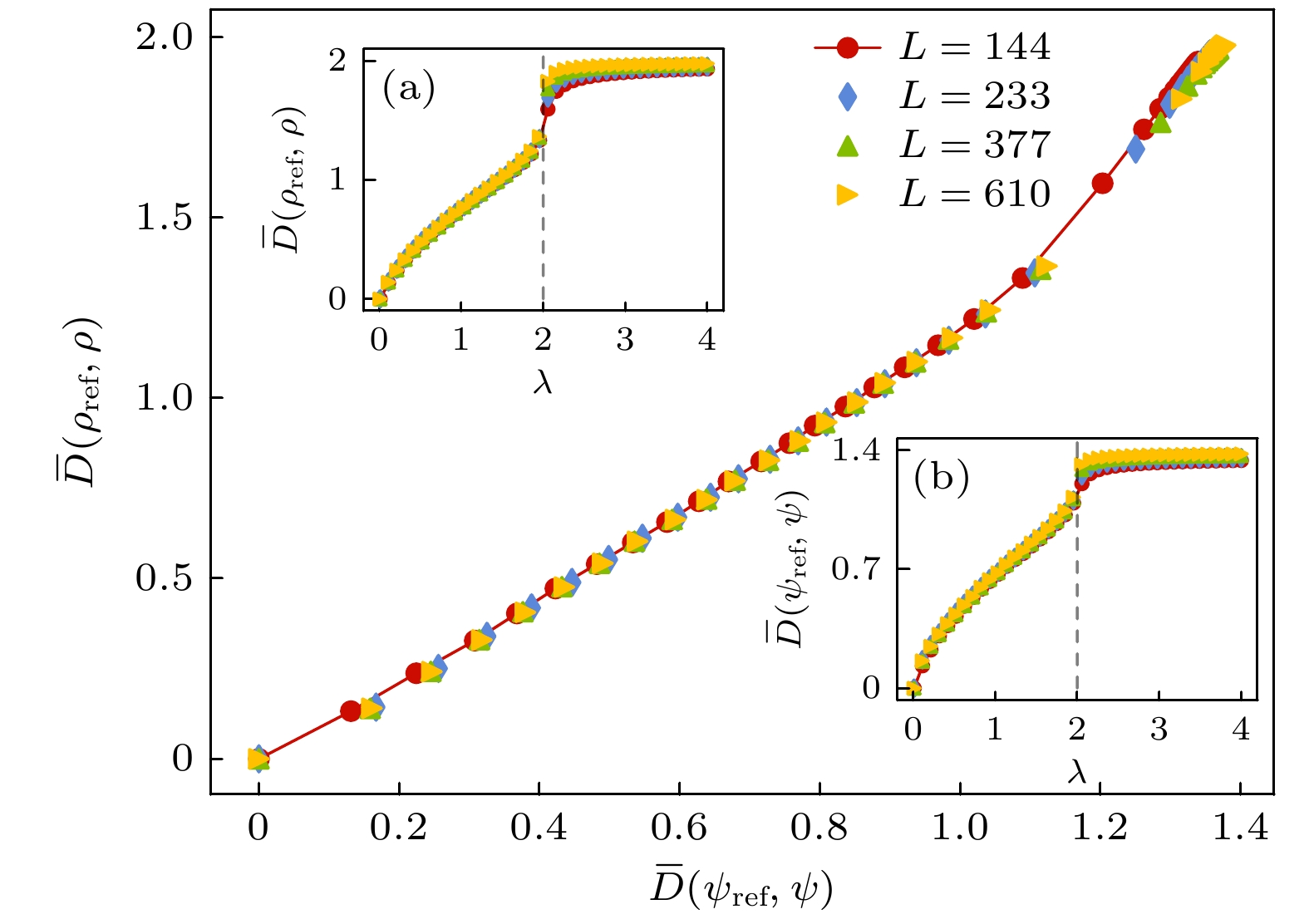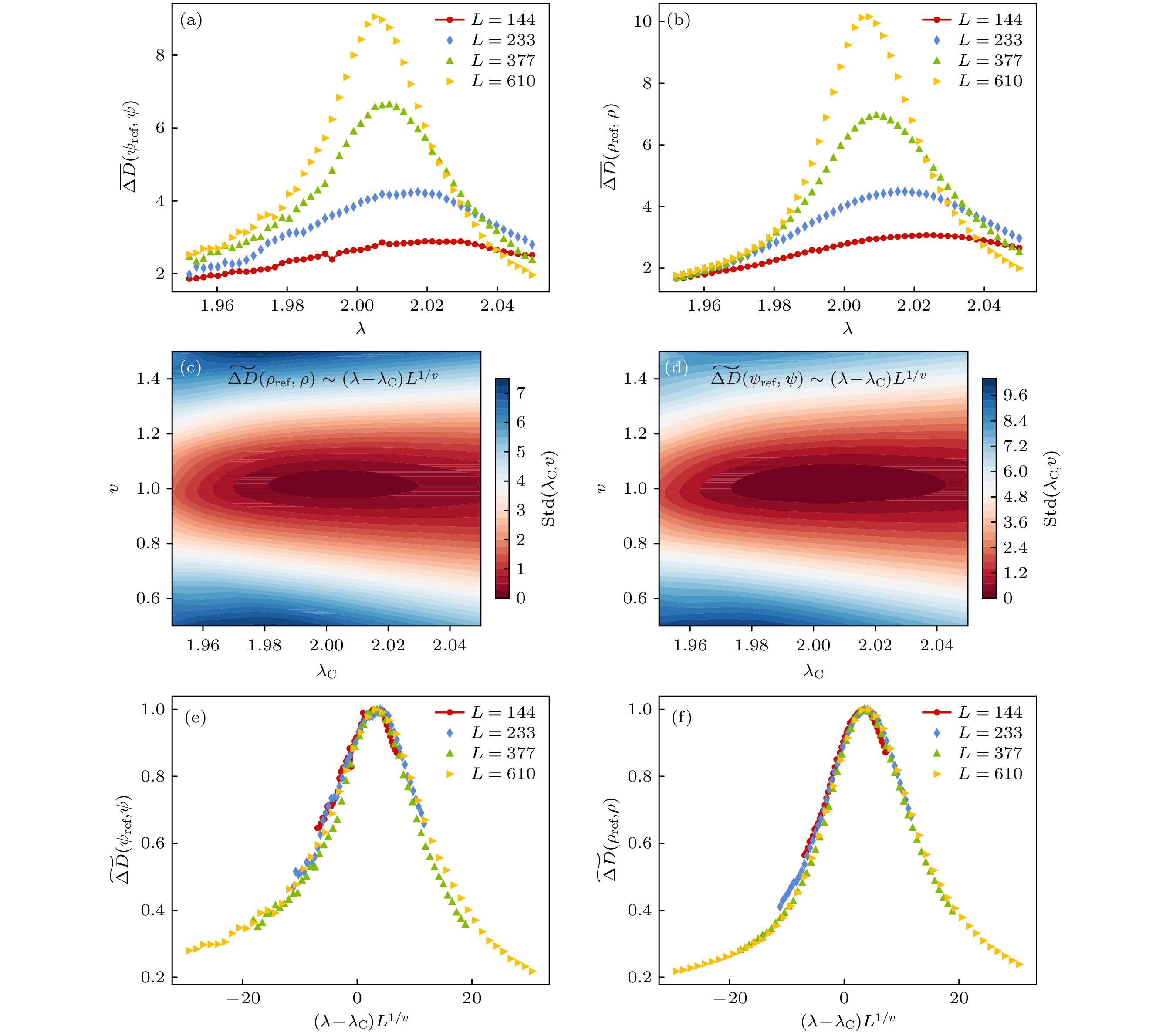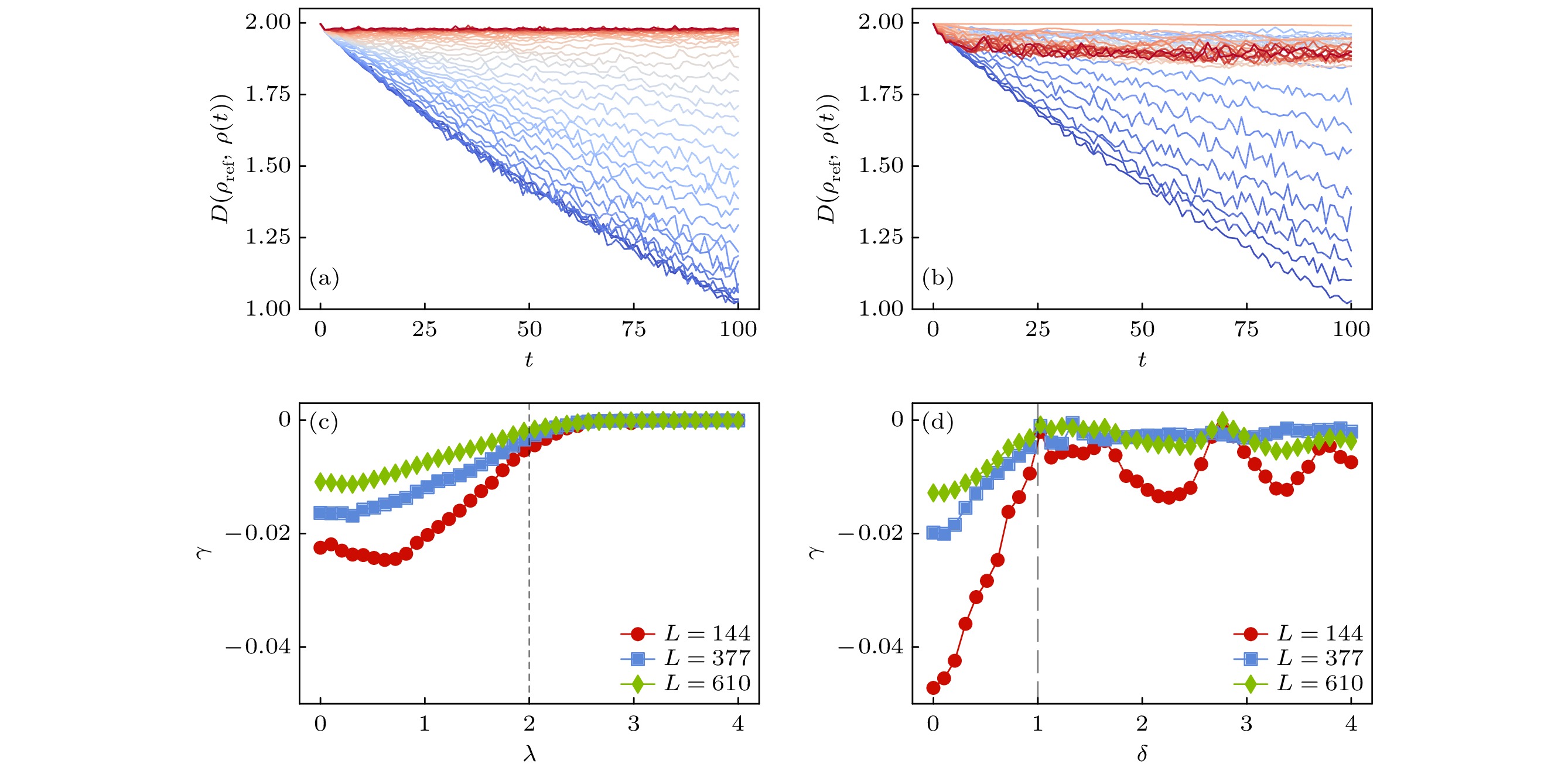-
得益于量子信息理论的发展, 保真度、纠缠熵等概念被引入到量子相变的研究中, 不仅能用来标识新奇的物质相, 还能用来探测量子相变的临界点以及描绘其临界行为. 从度量空间的角度来看, 这些物理量都可以被理解为度量空间中两个函数的距离. 本文利用波函数和实空间中密度分布函数的距离, 研究了以广义Aubry-André-Harper模型为代表的准周期系统, 发现该方法不仅能标识拓展相、临界相和局域相, 还能找到准确的相变点并计算出临界指数. 此外, 不仅将度量空间方法推广到波包扩散动力学研究, 还提出了一种新的量, 即态密度分布函数的距离, 发现上述定义的两种物理量都能标识不同的物质相及相变点. 通过定义某个函数在不同参数下的距离, 不仅为标识已知系统相变点提供了研究工具, 还为探测未知系统的不同物质相、相变点及其临界行为提供了一种直观的方法.Due to the rapid advancement of quantum information theory, some concepts such as fidelity and entanglement entropy have been introduced into the study of quantum phase transitions, which can be used not only to identify novel matter phases but also to detect the critical point and describe the critical behavior of the quantum phase transitions. From the point of view of the metric space, these physical quantities can be understood as the distance between the two functions in the metric space. In this work, we study a class of quasi-periodic system represented by the generalized Aubry-André-Harper (AAH) model, by using the distance between various wavefunctions or density distribution functions in real space. The generalized AAH model, an ideal platform to understand Anderson localization and other novel quantum phenomena, provides rich phase diagrams including extended, localized, even critical (multifractal) phases and can be realized in a variety of experimental platforms. In the standard AAH model, we find that the extended and localized phases can be identified. In addition, there exists a one-to-one correspondence between two distinct distances. We are able to precisely identify the critical point and compute the critical exponent by fitting the numerical results of different system sizes. In the off-diagonal AAH model, a complete phase diagram including extended phase, localized phase, and critical phase is obtained and the distance of critical phases is intermediate between the localized phase and extended phase. Meanwhile, we apply the metric space method to the wave packet propagation and discover that depending on the phase, the distance between wave functions or density functions exhibits varying dynamical evolution behavior, which is characterized by the exponent of the power-law relationship varying with time. Finally, the distance between the state density distribution functions is proposed, and it effectively identifies distinct matter phases and critical points. The critical phase which displays a multifractal structure, when compared with the other two phases, has the large state density distribution function distance. In a word, by defining the distances of a function under different parameters, we provide not only a physical quantity to identify familiar phase transitions but also an intuitive way to identify different matter phases of unknown systems, phase transition points, and their critical behaviors.
-
Keywords:
- quantum phase transitions /
- metric space /
- quasi-periodic systems /
- localization
[1] Sachdev S 2011 Quantum Phase Transition (2nd Ed.) (Cambridge: Cambridge University Press) pp3–8
[2] Gu S J 2010 Int. J. Mod. Phys. B 24 4371
 Google Scholar
Google Scholar
[3] Wei B B 2019 Phys. Rev. A 99 042117
 Google Scholar
Google Scholar
[4] Lü T, Liu Y B, Yi T C, Li L S, Liu M X, You W L 2022 Phys. Rev. B 106144205
 Google Scholar
Google Scholar
[5] Lü T, Yi T C, Li L S, Sun G Y, You W L 2022 Phys. Rev. A 105 013315
 Google Scholar
Google Scholar
[6] Osborne T J, Nielsen M A 2002 Phys. Rev. A 66 032110
 Google Scholar
Google Scholar
[7] Osterloh A, Amico L, Falci G, Fazio R 2002 Nature 416 608
 Google Scholar
Google Scholar
[8] Marzolino U, Prosen T 2017 Phys. Rev. B 96 104402
 Google Scholar
Google Scholar
[9] Yin S Y, Song J, Zhang Y J, Liu S T 2019 Phys. Rev. B 100 184417
 Google Scholar
Google Scholar
[10] Sun Z, Ma J, Lu X M, Wang X G 2010 Phys. Rev. A 82 022306
 Google Scholar
Google Scholar
[11] Huang Y X, Zhong W, Sun Z, Wang X G 2012 Phys. Rev. A 86 012320
 Google Scholar
Google Scholar
[12] Wang T L, Wu L N, Yang W, Jin G R, Lambert N, Nori F 2014 New J. Phys. 16 063039
 Google Scholar
Google Scholar
[13] Shen H T, Zhang P F, Fan R H, Zhai H 2017 Phys. Rev. B 96 054503
 Google Scholar
Google Scholar
[14] Huang Y C, Brandão F G S L, Zhang Y L 2019 Phys. Rev. Lett. 123 010601
 Google Scholar
Google Scholar
[15] Lin C J, Motrunich O I 2018 Phys. Rev. B 97 114304
 Google Scholar
Google Scholar
[16] Sharp P M, D’Amico I 2014 Phys. Rev. B 89 115137
 Google Scholar
Google Scholar
[17] Sharp P M, D’Amico I 2015 Phys. Rev. A 92 032509
 Google Scholar
Google Scholar
[18] D'Amico I, Coe J P, Franca V V, Capelle K 2011 Phys. Rev. Lett. 106 050401
 Google Scholar
Google Scholar
[19] Skelt A H, Godby R W, D’Amico I 2018 Phys. Rev. A 98 012104
 Google Scholar
Google Scholar
[20] Aubry S, André G 1980 Ann. Israel Phys. Soc. 3 18
[21] Harper P G 1955 Proc. Phys. Soc. London, Sect. A 68 874
 Google Scholar
Google Scholar
[22] Domínguez-Castro G A, Paredes R 2019 Cent. Eur. J. Phys. 40 045403
 Google Scholar
Google Scholar
[23] Biddle J, Das Sarma S 2010 Phys. Rev. Lett. 104 070601
 Google Scholar
Google Scholar
[24] Cestari J C C, Foerster A, Gusmão M A 2016 Phys. Rev. B 93 205441
 Google Scholar
Google Scholar
[25] Longhi S 2019 Phys. Rev. B 100 125157
 Google Scholar
Google Scholar
[26] Modugno G 2010 Rep. Prog. Phys. 73 102401
 Google Scholar
Google Scholar
[27] 刘通, 高先龙 2016 物理学报 65 117101
 Google Scholar
Google Scholar
Liu T, Gao X L 2016 Acta Phys. Sin. 65 117101
 Google Scholar
Google Scholar
[28] Liu T, Wang P, Gao X L 2016 arXiv: 1609.06939 [cond-mat.dis-nn
[29] Roati G, D’Errico C, Fallani L, Fattori M, Fort C, Zaccanti M, Modugno G, Modugno M, Inguscio M 2008 Nature 453 895
 Google Scholar
Google Scholar
[30] Xiao T, Xie D Z, Dong Z L, Chen T, Yi W, Yan B 2012 Phys. Rev. Lett. 109 106402
 Google Scholar
Google Scholar
[31] Negro L D, Oton C J, Gaburro Z, Pavesi L, Pavesi P, Lagendijk A, Righini R, Colocci M, Wiersma D S 2003 Phys. Rev. Lett. 90 055501
 Google Scholar
Google Scholar
[32] Verbin M, Zilberberg O, Kraus Y E, Lahini Y, Silberberg Y 2013 Phys. Rev. Lett. 110 076403
 Google Scholar
Google Scholar
[33] Lahini Y, Pugatch R, Pozzi F, Sorel M, Morandotti R, Morandotti N, Silberberg Y 2009 Phys. Rev. Lett. 103 013901
 Google Scholar
Google Scholar
[34] Guo Q J, Cheng C, Sun Z H, Song Z X, Li H K, Wang Z, Ren W H, Dong H, Zheng D G, Zhang Y R, Fan H, Wang H 2021 Nat. Phys. 17 234
 Google Scholar
Google Scholar
[35] Li H, Wang Y Y, Shi Y H, Huang K X, Song X H, Liang G H, Mei Z Y, Zhou B Z, Zhang H, Zhang J Z, Chen S, Zhao S P, Tian Y, Yang Z Y, Xiang Z C, Xu K, Zheng D G, Fan H 2023 npj Quantum Inf. 9 40
 Google Scholar
Google Scholar
[36] Liu F L, Ghosh S, Chong Y D 2015 Phys. Rev. B 91 014108
 Google Scholar
Google Scholar
[37] Tong X Q, Meng Y M, Jiang X D, Lee C H, Neto G, Gao X L 2021 Phys. Rev. B 103 104202
 Google Scholar
Google Scholar
-
图 1 不同尺寸下平均波函数距离随平均密度距离的变化. 插图(a), (b)的横坐标皆为无序强度$ \lambda $, 纵坐标分别为平均密度距离和平均波函数距离. 不同颜色的线代表不同尺寸下的结果, 无序平均次数取为50
Fig. 1. Variation of average wave function distance with the average density distance. Abscissa of panels (a) and (b) are the disorder intensity $ \lambda $, and the ordinates are the average density distance and average wave function distance, respectively. Color bar represents the result under different size, and the disorder realizations are 50
图 2 一维AAH模型中一阶平均波函数距离和密度距离的有限尺度分析 (a), (b)不同尺寸下一阶平均波函数距离和密度距离随无序强度$ \lambda $的变化; (c), (d)不同拟合参数下, 有限尺寸分析的误差$ {\rm Std}(\lambda_{{\mathrm{C}}}, v) $, 颜色棒的深浅为误差的大小; (e), (f)缩放一阶平均波函数距离及缩放一阶平均密度距离作为缩放变量$ (\lambda-\lambda_{\mathrm{C}} )L^{1/v} $的函数. 无序平均次数为50次
Fig. 2. Finite scale analysis of the first-order average wave function distance and density distance in the one-dimensional AAH model: (a), (b) Variation of first-order average wave function distance and density distance with disordered intensity $ \lambda $ under different sizes; (c), (d) error of finite size analysis under different fitting parameters $ {\rm Std} (\lambda_{{\mathrm{C}}}, v) $. Color bar represents the value of the error; (e), (f) scaling of the first-order average wave function distance and the first-order average density distance as a function of the scaling variable $ (\lambda-\lambda_{\mathrm{C}} )L^{1/v} $. The disorder realizations are 50.
图 3 广义AAH模型的相图. 颜色的深浅代表$ \overline{D}(\rho_{\rm ref}, \rho) $的大小, 这里选择$ L=610 $. 绿色区域A为拓展相, 橙色区域B为临界相, 蓝色区域C为局域相. 无序平均的次数取为50次
Fig. 3. Phase diagram of the extended AAH model. Color bar represents the value of $ \overline{D}(\rho_{\rm ref}, \rho) $, calculated for chains of length $ L=610 $. Green region A represents the extended phase, the orange region B represents the critical phase, and the blue region C represents the localized phase. Disorder realizations are 50.
图 4 密度距离的动力学演化 (a) $ \delta = 0 $, 由蓝线至红线, $ \lambda $逐渐增大; (b) $ \lambda = 0 $, 由蓝线至红线, $ \delta $逐渐增大; (c)不同尺寸下, $ \gamma $作为无序强度$ \lambda $的函数; (d)不同尺寸下, $ \gamma $作为无序强度$ \delta $的函数
Fig. 4. Dynamical evolution of the density distance: (a) From the blue to the red line, the $ \lambda $ gradually increases ($ \delta = 0 $); (b) from the blue to the red line, the $ \delta $ gradually increases ($ \lambda = 0 $); (c) under different sizes, $ \gamma $ is a function of disorder intensity $ \lambda $; (d) under different sizes, $ \gamma $ is a function of disorder intensity $ \delta $.
图 5 态密度距离图 (a)在L = 610下, 以$ \lambda = 0.01, \; \delta =0 $为参考系统的态密度距离随参数的变化. 红线为当$ \lambda = 0 $, 态密度距离随参数$ \delta $的变化. 蓝线为当$ \delta = 0 $, 态密度距离随参数$ \lambda $的变化. (b)以基态为零能点, 当$ \delta = 0 $, $ \lambda= 1.0, 2.0, 4.0 $, 即红线、蓝线、绿线, 分别代表拓展态、临界态和局域态的约化态密度图. 无序平均次数为50次
Fig. 5. Density of state distance: (a) At L = 610, density of state distance of the reference system varies with parameters $ \lambda $ and $ \delta $. The red line represents the variation of the density-of-state distance with parameter $ \delta $ when $ \lambda=0 $. The blue line represents the variation of the density of state distance with parameter $ \lambda $ when $ \delta=0 $. (b) Reduced density of states by taking the ground state as the zero-energy point. $ \delta=0 $, $ \lambda=1.0, \;2.0,\;4.0 $, namely, the red line, blue line, and green line, respectively, represent the extended state, critical state, and localized state. The disorder realizations are 50.
-
[1] Sachdev S 2011 Quantum Phase Transition (2nd Ed.) (Cambridge: Cambridge University Press) pp3–8
[2] Gu S J 2010 Int. J. Mod. Phys. B 24 4371
 Google Scholar
Google Scholar
[3] Wei B B 2019 Phys. Rev. A 99 042117
 Google Scholar
Google Scholar
[4] Lü T, Liu Y B, Yi T C, Li L S, Liu M X, You W L 2022 Phys. Rev. B 106144205
 Google Scholar
Google Scholar
[5] Lü T, Yi T C, Li L S, Sun G Y, You W L 2022 Phys. Rev. A 105 013315
 Google Scholar
Google Scholar
[6] Osborne T J, Nielsen M A 2002 Phys. Rev. A 66 032110
 Google Scholar
Google Scholar
[7] Osterloh A, Amico L, Falci G, Fazio R 2002 Nature 416 608
 Google Scholar
Google Scholar
[8] Marzolino U, Prosen T 2017 Phys. Rev. B 96 104402
 Google Scholar
Google Scholar
[9] Yin S Y, Song J, Zhang Y J, Liu S T 2019 Phys. Rev. B 100 184417
 Google Scholar
Google Scholar
[10] Sun Z, Ma J, Lu X M, Wang X G 2010 Phys. Rev. A 82 022306
 Google Scholar
Google Scholar
[11] Huang Y X, Zhong W, Sun Z, Wang X G 2012 Phys. Rev. A 86 012320
 Google Scholar
Google Scholar
[12] Wang T L, Wu L N, Yang W, Jin G R, Lambert N, Nori F 2014 New J. Phys. 16 063039
 Google Scholar
Google Scholar
[13] Shen H T, Zhang P F, Fan R H, Zhai H 2017 Phys. Rev. B 96 054503
 Google Scholar
Google Scholar
[14] Huang Y C, Brandão F G S L, Zhang Y L 2019 Phys. Rev. Lett. 123 010601
 Google Scholar
Google Scholar
[15] Lin C J, Motrunich O I 2018 Phys. Rev. B 97 114304
 Google Scholar
Google Scholar
[16] Sharp P M, D’Amico I 2014 Phys. Rev. B 89 115137
 Google Scholar
Google Scholar
[17] Sharp P M, D’Amico I 2015 Phys. Rev. A 92 032509
 Google Scholar
Google Scholar
[18] D'Amico I, Coe J P, Franca V V, Capelle K 2011 Phys. Rev. Lett. 106 050401
 Google Scholar
Google Scholar
[19] Skelt A H, Godby R W, D’Amico I 2018 Phys. Rev. A 98 012104
 Google Scholar
Google Scholar
[20] Aubry S, André G 1980 Ann. Israel Phys. Soc. 3 18
[21] Harper P G 1955 Proc. Phys. Soc. London, Sect. A 68 874
 Google Scholar
Google Scholar
[22] Domínguez-Castro G A, Paredes R 2019 Cent. Eur. J. Phys. 40 045403
 Google Scholar
Google Scholar
[23] Biddle J, Das Sarma S 2010 Phys. Rev. Lett. 104 070601
 Google Scholar
Google Scholar
[24] Cestari J C C, Foerster A, Gusmão M A 2016 Phys. Rev. B 93 205441
 Google Scholar
Google Scholar
[25] Longhi S 2019 Phys. Rev. B 100 125157
 Google Scholar
Google Scholar
[26] Modugno G 2010 Rep. Prog. Phys. 73 102401
 Google Scholar
Google Scholar
[27] 刘通, 高先龙 2016 物理学报 65 117101
 Google Scholar
Google Scholar
Liu T, Gao X L 2016 Acta Phys. Sin. 65 117101
 Google Scholar
Google Scholar
[28] Liu T, Wang P, Gao X L 2016 arXiv: 1609.06939 [cond-mat.dis-nn
[29] Roati G, D’Errico C, Fallani L, Fattori M, Fort C, Zaccanti M, Modugno G, Modugno M, Inguscio M 2008 Nature 453 895
 Google Scholar
Google Scholar
[30] Xiao T, Xie D Z, Dong Z L, Chen T, Yi W, Yan B 2012 Phys. Rev. Lett. 109 106402
 Google Scholar
Google Scholar
[31] Negro L D, Oton C J, Gaburro Z, Pavesi L, Pavesi P, Lagendijk A, Righini R, Colocci M, Wiersma D S 2003 Phys. Rev. Lett. 90 055501
 Google Scholar
Google Scholar
[32] Verbin M, Zilberberg O, Kraus Y E, Lahini Y, Silberberg Y 2013 Phys. Rev. Lett. 110 076403
 Google Scholar
Google Scholar
[33] Lahini Y, Pugatch R, Pozzi F, Sorel M, Morandotti R, Morandotti N, Silberberg Y 2009 Phys. Rev. Lett. 103 013901
 Google Scholar
Google Scholar
[34] Guo Q J, Cheng C, Sun Z H, Song Z X, Li H K, Wang Z, Ren W H, Dong H, Zheng D G, Zhang Y R, Fan H, Wang H 2021 Nat. Phys. 17 234
 Google Scholar
Google Scholar
[35] Li H, Wang Y Y, Shi Y H, Huang K X, Song X H, Liang G H, Mei Z Y, Zhou B Z, Zhang H, Zhang J Z, Chen S, Zhao S P, Tian Y, Yang Z Y, Xiang Z C, Xu K, Zheng D G, Fan H 2023 npj Quantum Inf. 9 40
 Google Scholar
Google Scholar
[36] Liu F L, Ghosh S, Chong Y D 2015 Phys. Rev. B 91 014108
 Google Scholar
Google Scholar
[37] Tong X Q, Meng Y M, Jiang X D, Lee C H, Neto G, Gao X L 2021 Phys. Rev. B 103 104202
 Google Scholar
Google Scholar
计量
- 文章访问数: 5425
- PDF下载量: 275
- 被引次数: 0














 下载:
下载:




